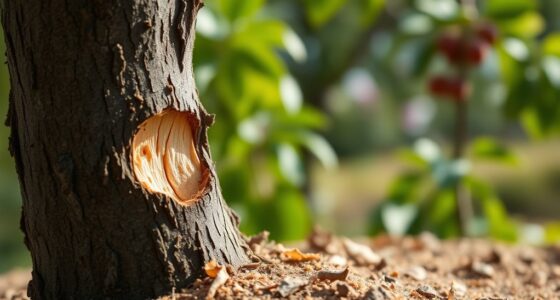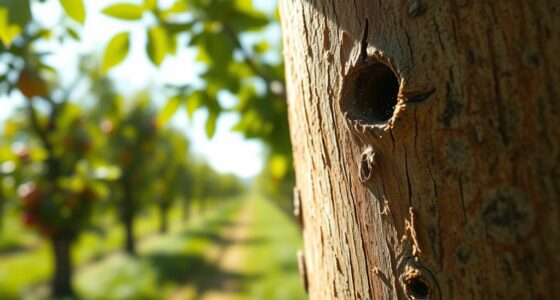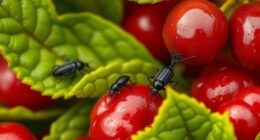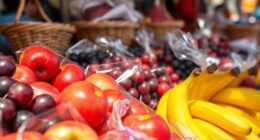Insect-related fruit drop occurs when pests like aphids or fruit flies damage flowers or young fruit, causing them to fall prematurely. Physiological causes, such as poor pollination, nutrient deficiencies, or environmental stresses, lead to fruit dropping without pest presence. To manage these issues effectively, it’s important to identify the cause—pests or physiological factors. Continuing now will help you learn how to distinguish between them and apply the right solutions.
Key Takeaways
- Insect-related fruit drop involves pest damage such as feeding, entry points, and internal decay, while physiological drop results from pollination failure or nutrient deficiencies.
- Insects like fruit flies and beetles cause early shedding by damaging blossoms or young fruit; physiological drop occurs without visible pest signs.
- Effective pest management reduces insect-induced fruit drop; improving pollination, fertilization, and watering addresses physiological causes.
- Pests typically cause localized damage; physiological drop often correlates with environmental stress or nutrient deficiencies affecting overall fruit support.
- Correct diagnosis differentiates insect damage from physiological issues, guiding targeted interventions for fruit retention.
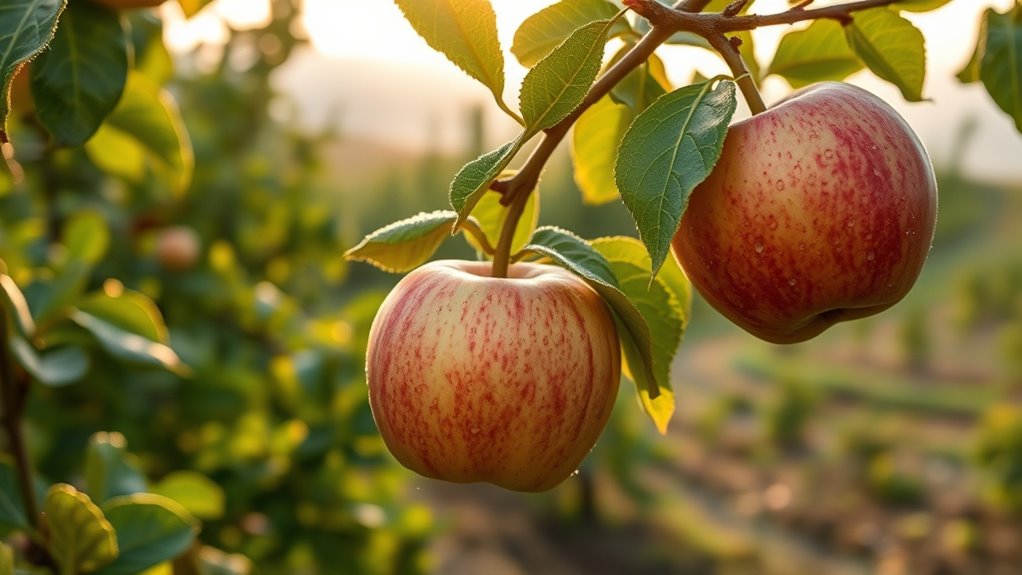
Fruit drop can be caused by a variety of factors, mainly insect activity and physiological issues within the tree. When it comes to physiological causes, one critical aspect to ponder is pollination success. If the flowers aren’t pollinated properly, the fruit may not develop fully and can drop prematurely. Poor pollination can result from a lack of pollinators like bees or unfavorable weather during flowering, leading to fewer fertilized ovules. Without adequate pollination, the tree recognizes that the developing fruit isn’t viable and sheds it to conserve resources for future growth. Besides pollination, nutrient deficiency plays a substantial role in physiological fruit drop. When the soil lacks essential nutrients such as calcium, magnesium, or boron, the tree struggles to support developing fruit, causing it to drop early. Nutrient deficiencies weaken the fruit’s cell walls and overall structural integrity, making it more prone to falling off before reaching maturity. You might notice fruit drop after periods of drought or irregular watering, which can exacerbate nutrient deficiencies by limiting nutrient uptake. Ensuring your tree receives balanced fertilization tailored to its needs helps maintain proper nutrient levels, reducing the likelihood of physiological fruit drop.
Insect activity, on the other hand, causes fruit drop through direct damage or disruption of the tree’s natural processes. For example, certain insects like fruit flies, aphids, or beetles can infest the fruit itself or the flowers during pollination. These pests feed on the blossoms or young fruit, impairing development and triggering early shedding. Insect feeding can also introduce diseases or create entry points for pathogens that weaken the fruit’s tissues, making them more susceptible to dropping. Additionally, some insects, like codling moths, lay eggs inside developing fruit, leading to larval infestation. The damage caused by larvae often results in the fruit falling off prematurely, either due to internal decay or because the tree perceives it as unfit. You need to monitor pest populations regularly and take proactive control measures, such as insecticides or biological controls, to prevent infestations from causing substantial fruit loss. Preventing insect-related fruit drop requires integrated pest management practices that keep pests at manageable levels, ensuring healthy fruit development.
Understanding the distinction between insect-related and physiological causes of fruit drop helps you address the problem more effectively. If you notice fruit falling early without signs of pest infestation, physiological issues like pollination failure or nutrient deficiency are likely culprits. Conversely, if pests are present and damaging the fruit or flowers, then insect activity needs to be your primary focus. Proper management involves a combination of ensuring good pollination, maintaining soil health with proper fertilization, and controlling pests through integrated methods. By identifying the root cause and taking targeted action, you can considerably reduce fruit drop and improve your harvest quality.
Frequently Asked Questions
How Can I Differentiate Between Insect Damage and Physiological Fruit Drop?
To differentiate between insect damage and physiological fruit drop, start with a visual inspection of the affected fruits. Insect damage often shows irregular holes, chew marks, or frass, while physiological drop usually results in clean, smooth scars or uniform shedding. Damage patterns also differ; insects tend to target specific areas, whereas physiological drop occurs more randomly. Recognizing these signs helps you identify the cause accurately.
What Are the Most Effective Organic Methods to Prevent Insect-Related Fruit Drop?
Imagine you’re managing a orchard, and you notice early fruit drop. To prevent insect-related fruit drop organically, try companion planting—like planting marigolds near your fruit trees to repel pests. Additionally, encourage natural predators such as ladybugs and parasitic wasps, which feed on harmful insects. These methods create a balanced ecosystem, reducing pest populations naturally, and help keep your fruit on the tree longer and healthier.
Which Fruit Varieties Are Most Susceptible to Physiological Fruit Drop?
You’ll find that susceptible varieties like cherries, apples, and grapes are more prone to physiological fruit drop due to their inherent physiological tendencies, especially during periods of rapid growth or environmental stress. These varieties often have higher tendencies for fruit abscission, making them more vulnerable. To minimize this, monitor environmental conditions closely and guarantee proper nutrition and watering, helping reduce stress and support fruit retention.
How Does Weather Influence Physiological Fruit Drop in Different Regions?
Ever wondered how weather influences fruit drop? In different regions, weather patterns and regional climates play a big role. Sudden temperature fluctuations, droughts, or excessive rainfall can stress trees, causing physiological fruit drop. You’ll notice more drop in areas with unpredictable weather, especially during key growth stages. Understanding local climate trends helps you better manage and reduce fruit loss, ensuring your harvest stays healthy and abundant regardless of regional weather challenges.
Are There Specific Nutrients That Can Reduce Physiological Fruit Drop?
You can reduce physiological fruit drop by using nutritional supplements like calcium and boron, which strengthen fruit development. Soil amendments such as organic matter or balanced fertilizers improve nutrient availability, supporting healthy fruit retention. Ensuring your trees get the right nutrients helps maintain fruit growth, minimizes stress, and reduces drop due to physiological causes. Regular testing and adjusting your fertilization plan based on soil conditions can make a significant difference in fruit retention.
Conclusion
You now see that fruit drop is like a delicate dance between tiny insects and the tree’s own signals. Insects are unwelcome guests, causing chaos like storm clouds blotting the sun. Meanwhile, physiological factors are the tree’s whispers, subtle as a gentle breeze guiding fruit to fall. By understanding both, you can protect your orchard like a vigilant gardener tending a thriving, balanced garden where every fruit finds its perfect place to rest.

